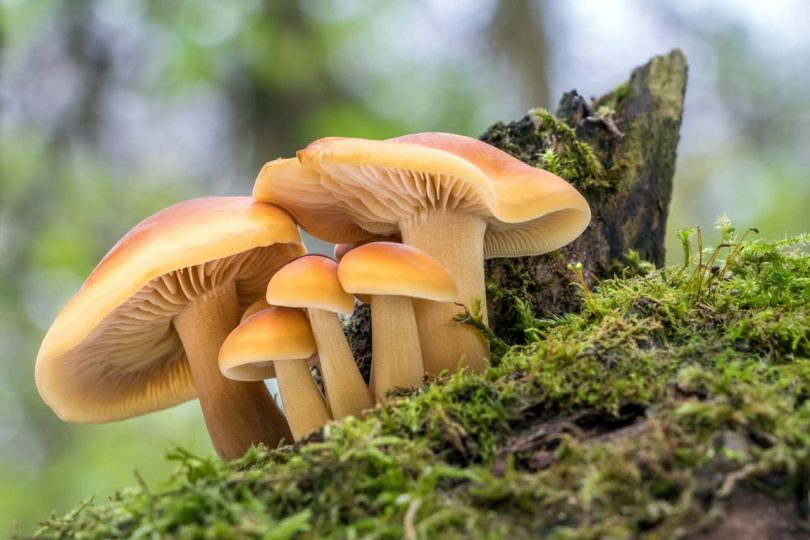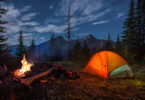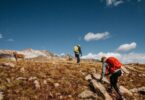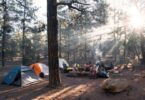Time spent outdoors can benefit your health in several ways, especially if you are on a camping trip. Taking steps to recharge is essential to boost the brain by getting away from the mundane routine of everyday life.
That said, while the benefits of camping are many, it does pose a challenge to ensure that the food you are picking up on the forest trails is healthy and good enough for you to eat. It is also a good idea to pick an interesting trail so you can enjoy a good route. You can read about different routes here trailplace.com before making up your mind on picking a foraging path.
For example, people have been foraging in the wild for mushrooms since time immemorial, both as a food as well as a rewarding hobby, but those who do it on a camping trip are advised to tread with caution.
This is because in spite of some varieties being highly nutritious, tasty and safe to consume, there are many others that can not only pose a serious health risk but could be fatal as well.
It is therefore critical to know when hunting for mushrooms while camping as to which ones are edible and the ones that are poisonous. Here is a list of the ones to eat and those to avoid altogether.
Hen-of-the-woods (Grifola frondosa)
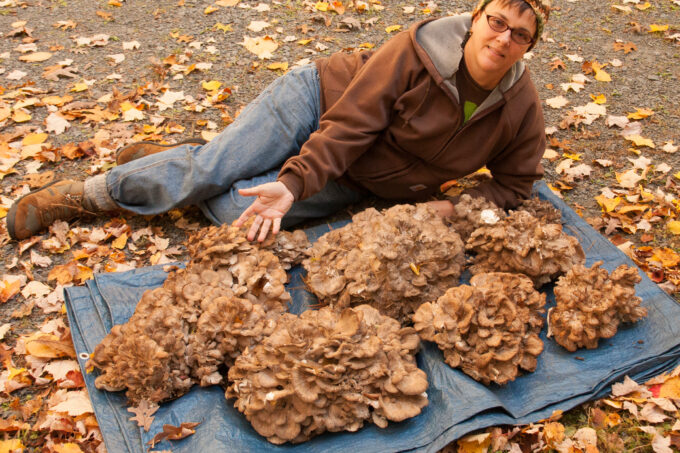
Source: backyardforager.com
This is one of the most sought after edible mushroom varieties and a firm favorite of the mushroom hunters. Hen-of-the-woods grow in small clusters and are found on the bases of hardwood trees such as oaks etc. They get their name from the tail feathers of a hen which these clusters resemble.
Hen-of-the-woods is basically a native of China but also grows round the year in North America and Japan. They can be identified by their grayish brown color, with white undersides. These mushrooms can grow up to 23kg but normally weigh between 1.5-7kg.
The safest way to identify this mushroom is that it does not have gills and the underside has tiny pores. Most studies have indicated that the Hen-of-the-woods may have anti-cancer and anti-inflammatory properties.
Oyster mushroom (Pleurotus ostreatus)
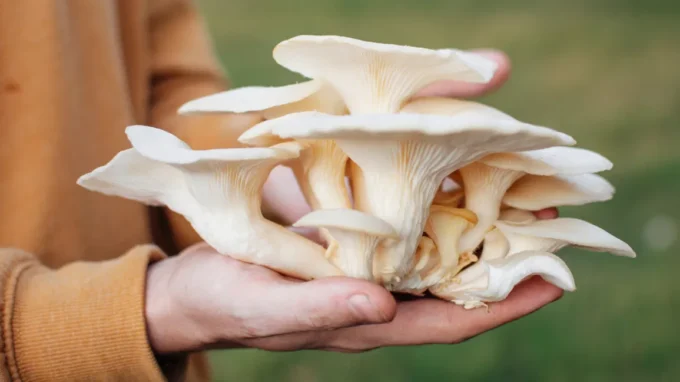
Source: healthline.com
These oyster shaped mushrooms grow near dead hardwood trees and can be found all over the world. This is another sought after variety you can forage during camping as it has a mild taste and an abundance of nutrients.
Oyster mushroom clusters are typically 2-8 inches wide and resemble a row of shelves on the dead and decaying branches and range in color from brown to gray, depending on the time of the year.
As far as their nutritional value is concerned, oyster mushrooms are particularly high in vitamin B2 as well as minerals such as potassium, copper, zinc and iron.
Sulphur shelf mushroom (Laetiporus sulphureus)
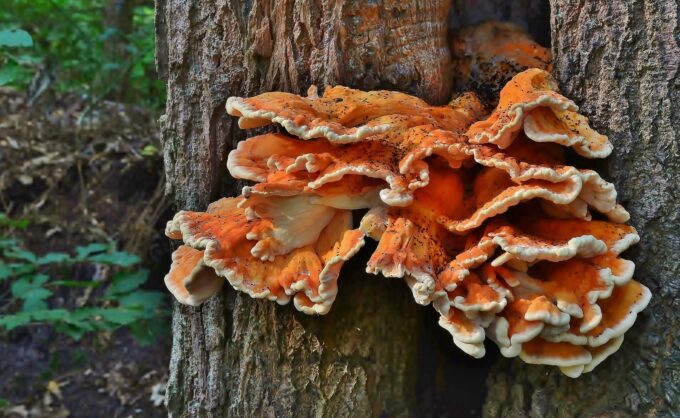
Source: ultimate-mushroom.com
Also known as the chicken mushroom, the sulphur shelf mushroom is known for its bright orange color and a unique meaty flavor.
These mushrooms are found abundantly on the rotting tree stumps of dead hardwood trees in Europe and North America, especially in the Colorado Rocky Mountains where they grow in overlapping clusters. There are no gills and the underside has tiny pores
Like other edible mushrooms, sulphur shelf mushrooms are also rich in health benefits like vitamin C, potassium, zinc and phosphorus. Many can be found on a single tree, with large ones weighing up to 23kg.
Sulphur shelf mushrooms should always be eaten cooked and never raw. They are best eaten by sauteing with butter and adding them to omelettes or vegetarian dishes.
Some other mushrooms which are safe to eat are the Giant Puffball, Beefsteak Fungus and Wood Ears(as long they are growing on elder) among others with no dangerous look alikes.
Mushrooms to avoid
Here are some poisonous mushrooms while should never be consumed as they pose a serious health hazard:
- Death Cap (Amanita phalloides) are among the most dangerous of all mushroom varieties responsible for deaths worldwide.
- Conocybe filaris grows in Asia, Europe and North America and contains toxins similar to Death Cap. They are brown and conical in shape and highly toxic.
- Autumn Skullcap (Galerina marginata), also referred to as the deadly ‘Galerina’, are another type of poisonous mushrooms which have small brown caps and grow on rotten wood.
- Death Angel (Amanita ocreata) bears a strong relationship with the Death Cap and grows mainly on the west coast of America. This mushroom causes severe illness and even death if ingested. Death Angels are white in color.
- False morels (Gyromitra esculenta and Gyromitra infula). Unfortunately False morels resemble edible true morels which makes them more dangerous than others. However, true morels are completely hollow, while False morels are not.
- Webcaps (Cortinarius species) This native of northern Europe comes in two varieties, the deadly webcap and the fool’s webcap. Both are similar to each other and feature a poison called orellanine which causes flu-like symptoms with a latency period of 2-3 weeks. If left untreated can cause kidney failure and eventually death.
- Deadly Dapperling (Lepiota brunneoincarnata) mushrooms are found near Massy in France and parts of Asia, and are known to contain amatoxins, when consumed can lead to severe toxicity in the liver and lethal consequences if not treated on time.
Tips and precautions
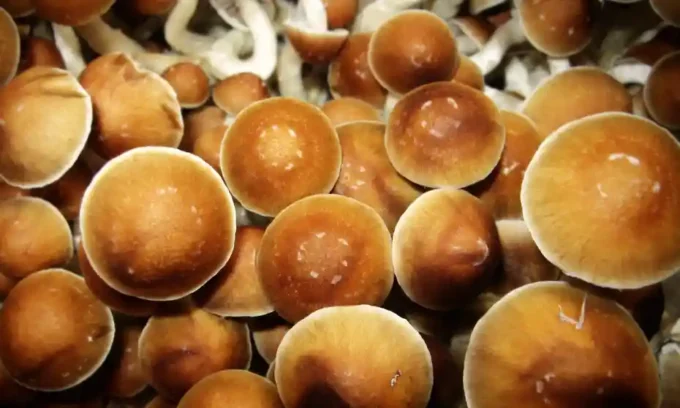
Source: theguardian.com
Wild mushrooms are hepatotoxic, which means they can directly harm the liver.This may sound scary to mushroom lovers, but there is no cause of worry once you distinguish between the edible ones and the poisonous ones. Here are some rules for beginners to follow when identifying mushrooms:
- Avoid mushrooms with a red cap or stem. It may not be harmful, but as a novice they are best avoided.
- Avoid mushrooms featuring white gills. This is a ring on the stem. Also ignore mushrooms with a bulbous base to be on the safer side.
Factors which can be of help
- The place of growth
- Smell of the mushroom
- Change in color while cutting them
- Shape, texture, color and size- bulbous, roots, rings etc
- Presence of pores or gills under the cap
- Texture of flesh
- Whether it is the right season of the year for that particular mushroom.
- Reject a bitten mushroom
- When foraging for mushrooms while camping in the wild, use a guide book or better still the services of a reputed mushroom hunter.

